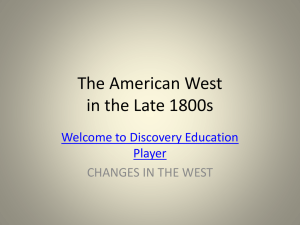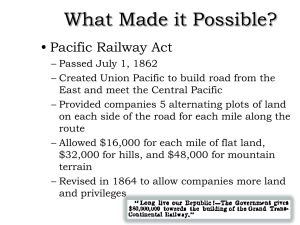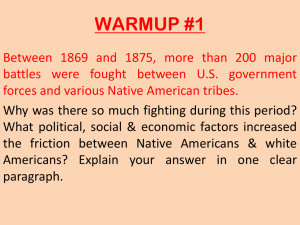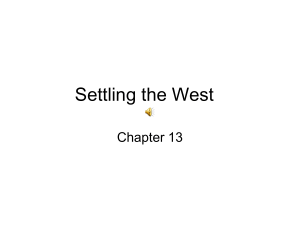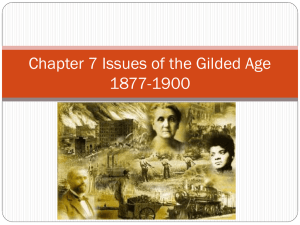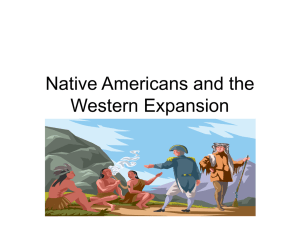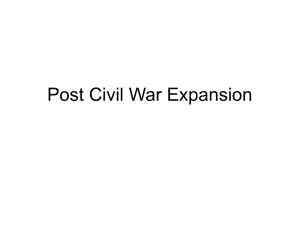Western Frontier Powerpoint
advertisement
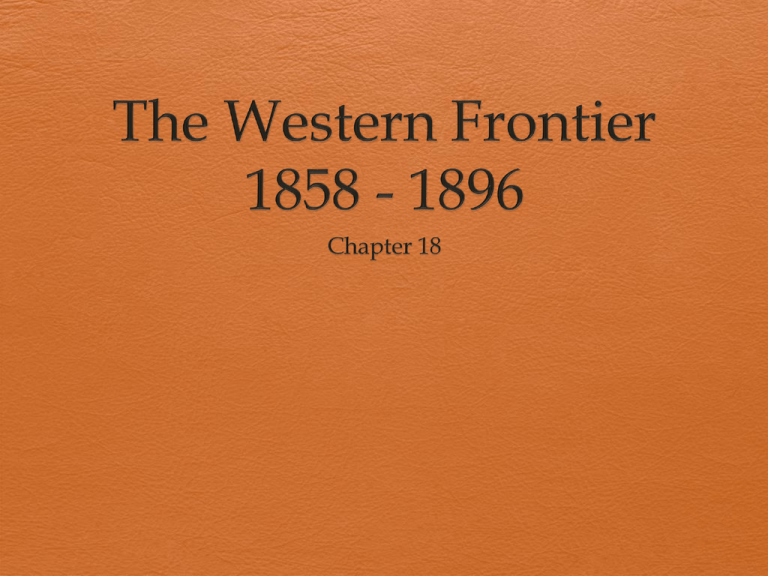
Mining is Big Business • Although the Gold Rush was ending in California, news of other gold mines sprang in other places • Pikes Peak was located in the Colorado Rockies and newspapers claimed that miners were given $20 a day panning for gold • This was more than what servants made ($1/day) Mining is Big Business However most of the gold was deep in underground lodes – rich streaks of ore sandwiched between layers of rock (ore) Mining the ore and then extracting the gold required expensive machinery, a lot of workers, and even an organized business Gold and silver mining attracted foreign investors as well such as the British who invested heavily in the industry The Comstock Lode This was the discover of a rich lode of silver-bearing ore on the banks of the Carson River in Colorado, but named after the investor Mining companies immediately set up shop there and reaped the benefits When Henry Comstock sold his share, he made $11,000 from it But this was only a fraction of the hundreds of millions of dollars worth of gold and silver pulled from the lode The Mining Frontier • • • • • • Boomtowns – were towns that grew up almost overnight around mining sites They were lively & lawless with people from all over Money came and went quickly because of lavish lifestyles Food, lodging, clothing and other goods cost a lot Violence was common where people carried large amounts of cash & guns; there was little police Vigilantes – were citizens who sometimes took the law into their own hands Women in Boomtowns Men definitely outnumbered women However some women worked as laundresses, cooks, or dance-hall entertainers They founded schools and churches They also worked to make the communities safer and more orderly Boom & Bust • “booms” were followed by “busts” • When the mines no longer had ore, people left. • They eventually turned into ghost towns – deserted as prospectors moved on to more promising sites or returned home • Some of these ghost towns still exist today as reminders of the glory days of the mining frontier New States Enter the Union Many people who went to these towns settled there permanently With the increase in population these areas eventually became states 1876: Colorado joins the US 1889: North Dakota, South Dakota, Washington, and Montana join the US 1890: Wyoming and Idaho join the US Railroads Mines operated far from the industrial centers of the East & Midwest Because of this, transportation played a vital role in survival of the mining communities The nation’s railroad network expanded rapidly since people needed shipments of food and other supplies Also to reach out to factories, ports, and markets to sell their gold/silver Government & the Railroad Government subsidies helped support railroad construction These were financial aid and land grants The federal government granted more than 130 million acres of land to the railroad companies Much of it was purchased or obtained by treaties from NA Spanning the Continent A search began for a transcontinental rail line – one that would span the continent and connect the Atlantic with the Pacific coasts Southerners wanted this line to run through the south, while northerners wanted it in the north; the north was chosen The challenge was to lay 1,700 miles of of track across hot plains and through rugged mountains 2 companies took on the challenge Transcontinental Railway May 10, 1869: construction was completed A Chinese crew was chosen to lay the final ten miles of track, complete in 12 hours Both sets of track met at Promontory Point in Utah Leland Stanford (gov. of California) drove a final golden spike into a tie to join the two railroads Effects of the Railroads 1883: 2 more transcontinental lines and dozes of shorter lines connected cities in the West with the rest of the nation They brought thousands of workers to the west, carried metals and produce to the east, manufactured goods to the west The demand for steel boosted the nation’s steel industry as did the production of coal, manufacturers of railroad cars, and construction of the tracks Cattle on the Plains • The Spanish brought over a breed of cattle with them when they settled Mexico & Texas • These cattle were called longhorn because of their prominent horns • Much of Texas was an open range – not fenced or divided into lots • Ranchers had to brand – burn a symbol – onto their cattle to distinguish them The Long Drive This was the herding of cattle 1,000 miles or more to meet the railroads These drives left Texas in the spring, where there was enough grass along the way to feed the cattle It was important to keep the cattle well fed so they could be sold The Chisholm Trail was a famous drive from central Texas to Kansas The Goodnight-Loving Trail headed west through NM and then turned north Life on the Trail Cowhands – those who herded/handled the cattle They had a difficult job because they had to ride up to 15 hours a day on the saddle in the rain, dust storms, and blazing sun It was also very lonely since these cowhands saw few outsiders Spanish Influence • Other than Confederate veterans & African Americans, Hispanics also made up the cowhand population • They had a tradition of cattle herding; they were called vaqueros • They developed many skills – riding, roping, and branding • Some Spanish words have made their way into the English dictionary from these cowhands • Words such as rancho which means ranch Cowhand Equipment • It was based on the vaquero equipment • They wore wide-brimmed hats to protect themselves from the sun • They also wore chaps – leather leggings – to shield themselves from brush and mishaps with cattle • They used lariats – ropes to lasso cattle that strayed from the herd Trouble on the Trail • • • • • Cowhands faced violent storms along the way, as well as “rustlers” who tried to steal their cattle Sometimes their cattle would get lost along the rivers The greatest danger, however, were stampedes – when thousands of cattle ran in panic Any sound could set off the cattle (thunder, or crack of gunshot) Cowhands had to race on horseback with the stampeding cattle and bring them under control The Wild West After tiresome weeks on the trail, the cowhands enjoyed some time off to rest They drank and gambled They got involved in fistfights and gunplay Some towns were rowdy, lawless, and often violent such as Dodge City and Abilene Farmers Settle the Plains The people who arrived in the Great Plains believed they could not farm the dry, treeless area However they soon turned the area from a “wilderness” to farmland The railroads made the journey west easier & cheaper New laws offered free land Above-average rainfall made the Plains better suited to farming Homestead Act 1862: Congress passed the Homestead Act This gave 160 free acres of land to a settler who paid a filing fee and lived on the land for five years This brought a lot of farmers to homestead – earn ownership of land by settling on it Promoting the Plains Homesteaders came to own land and be independent They were swayed by advertising paid for by: Railroads Steamship companies Land speculators Western states and territories African American Settlers Thousands of African Americans migrated from the southern states into Kansas They were called exodusters – from the biblical book of Exodus, which describes the Jews’ escape from slavery A.A also feared for their safety in former slave regions By 1881: more than 40,000 A.A had migrated to Kansas but some had to return because they lacked the money to start new farms or businesses The Farmers’ Frontier The climate presented a great challenge for farmers There was little rainfall but in some years the rain came down in large numbers – destroying crops & flooding areas On the other extreme, drought threatened crops and lives Fire was another challenge because brushfires swept rapidly though a region, destroying crops, livestock, and homes The Farmers’ Frontier Summer brought grasshoppers and other insects who would land on a field of corn When they left, not a single stalk of corn would remain Winters brought winds which howled across the open Plains Snow could bury the animals and trap families in their homes People always had to plan ahead and store food for the winter Farm Families Men labored hard in the fields Women did the same work but also cared for children A wife sewed clothing, made candles, and cooked and preserved food She also tended to the children’s health and education When the husband was away she would take his responsibilities Children worked on the farm when they got older and helped in the fields, tended animals, and did chores around the house New Farming Method Since the Plains could not be farmed by the usual methods, they had to find other ways of farming Plain farmers were known as sodbusters One of their methods was dry farming which was to plant seeds deep in the ground where there was some moisture Some of the tools they had were the light-weight steel lows Windmills helped to pump water from deep in the ground Barbed Wire were wire fences used to protect their land Oklahoma Land Rush This was the last part of the Plains to be settled However after years of pressure from land dealers and settlers’ groups, the federal government finally opened Oklahoma to homesteaders April 22, 1889: was the official opening day of the territory and at the sound of a bugle, the homesteaders charged across the border to stake their claims Oklahoma Land Rush These eager boomers – the homesteaders waiting to claim land – discovered that some settlers had already slipped into Oklahoma Sooners were the ones who had “snuck” in and already claimed most of the best land Closing the Frontier 1890: the government announced that the frontier no longer existed Settlement had changed the Plains dramatically No one felt these changes more harshly than the Native Americans who had live on the Plains for centuries Following the Buffalo • The Plains was home to Native American for centuries • Some lived in communities as farmers and hunters, while others were nomadic – moving from place to place • They traveled in search for food and followed the buffalo • They were divided into groups of up to 500 people each with a governing council • The women reared the children, cooked, and prepared hides while men hunted, traded, and supervised the military life Threats to the Buffalo • The Natives had millions of buffalo at their disposal but after the Civil War, American hunters slaughtered the animals to feed the crew building the railroads • Railroad companies also wanted to prevent huge herds of buffalo from blocking the trains • William Cody had claimed to have killed 4,000 buffalo in 19 months and earned the nickname Buffalo Bill Conflict In the beginning white settlers regarded the Plains as the “Great American Desert” Because of this, they left Native Americans alone When the whites began to settle, the situation changed and proposed new Indian policies Reservation Policy • 1867: the government appointed the Indian Peace Commission to deal with the NA • The Commission proposed to move the NA to a few large reservations – tracts of land set aside for them • Some of the reservations were in Oklahoma & the Dakota Territory How to Relocate NA Agents used trickery to persuade NA to move These reservation lands were located on poor lands and the government failed to deliver their promised food and supplies to the Natives Whatever was delivered was in poor quality Many Natives agreed to stay on the reservations or be relocated to other reservations Some, however, did resist Conflict on the Plains – The Sioux • Minnesota Territory was the site of a bloody confrontation • Sioux warriors, who were led by Red Cloud, burned and looted white settlers’ homes • Hundreds of people died before troops arrived to put down the uprising Conflict on the Plains – The Lakota The Lakota were another branch of Native Americans They fought hard to keep control of their hunting grounds from the Dakotas to Nebraska The Fetterman Massacre • • • • • • Native American groups staged a series of attacks The bloodies occurred on December 21, 1866 when army troops were manning a fort on the Bozeman Trail A Sioux military leader, Crazy Horse, acted as a decoy and lured the troops into a deadly trap He tricked them into sending a group of about 80 soldiers Hundreds of warriors were waiting in ambush and wiped out the entire group of soldiers This is known as the Fetterman Massacre Attacking the Miners Miners who moved out west for gold and silver had their wagons trains raided and their cattle & horses stolen These mining camps were no longer safe Dozens of ranches had been burned and settlers killed The governor of Colorado ordered the NA to surrender where he said they would be given food and protection Black Kettle • Several Natives surrendered but many did not • November 1864: Chief Black Kettle brought several hundred Cheyenne to negotiate a peace deal • They camped at Sand Creek • Colonel John Chivington led an attack on the unsuspecting Cheyenne Little Bighorn This tension arose in the Black Hills of the Dakotas The government promised “No white person or persons shall be permitted to settle upon or occupy” or even “to pass through” these hills Rumor had it that these hills contained gold An expedition was led into the hills where it was confirmed that gold did exist “from the grass roots down” People swarmed the area Little Bighorn The Sioux Natives protested against the trespassers Sitting Bull was an important leader of the Lakota Sioux tribe: “I do not want to sell any land. Not even this much” as he held a pinch of dust Sitting Bull gathered Sioux & Cheyenne warriors along Little Bighorn River in present-day Montana They were joined by Crazy Horse (another Sioux chief) and his forces Little Bighorn The US army responded by rounding up their soldiers, the Seventh Cavalry, led by Lieutenant Colonel George Custer Custer divided his regiment and attacked the NA on June 25, 1876 but he underestimated their strength 250 of Custer’s troops vs thousands of Sioux & Cheyenne Custer & his entire army lost their lives The NA triumph was short-lived after another army came and crushed them, sending them to reservations Many fled to Canada while others agreed to live on reservations because of starvation & exhaustion The Apache Wars This trouble occurred in the southwest The Chiracahua Apache had already been moved from their homeland and many of them resented living in reservations Apache leader, Geronimo, escaped and fled to Mexico with a small group of followers During the 1880s he led raids against settlers and the army in Arizona After being captured and being sent to the reservations many times, he continued to escape but finally gave up A Changing Culture Contributions to the change of life for Native Americans Movement of whites onto their land Slaughter of the buffalo United States Army attacks Reservation policy More change came when reformers wanted to abolish the reservations and absorb Native Americans into white American culture A Changing Culture Helen Hunt Jackson was a reformer who was horrified by the massacres of NA and the cruelty of the reservation system “It makes little difference . . . where one opens the record of the history of the Indians; every paged and every year has its dark stain” A Changing Culture 1887: Congress introduces the Dawes Act which aimed to eliminate what Americans regarded as the two weaknesses of Native American life: the lack of private property & the nomadic tradition It also proposed to break up the reservations and to end identification with a tribal group Each Native would receive a plot of land in order to encourage them to become farmers and American citizens Children would be sent to white-run boarding schools Wovoka The Dawes acted changed NA way of life and weakened their cultural traditions Therefore the Sioux turned to one a NA prophet named Wovoka He claimed that the Sioux could regain their former greatness if they performed a ritual known as the Ghost Dance The Ghost Dance This dance was a way for the Sioux to express their culture that was being destroyed The ritual spread and reservation officials became alarmed and decided to ban the dance The officials went to Sitting Bull and arrested him because they believed he was their chief; they shot him during the scuffle Wounded Knee After Sitting Bull’s death, several hundred Lakota Sioux fled in fear They gathered at Wounded Knee in South Dakota December 29, 1890: the US army went there to collect the Sioux’s weapons Suddenly, a pistol shot rang out, the army responded with fire and more than 200 Sioux and 25 soldiers were killed This marked the end of armed conflict between whites and NA; the NA lost their struggle The Farmers Organize The supply of crops grew faster than the demand for them and prices fell steadily 1866: bushel of wheat = $1.45 1880s: bushel of wheat = $0.80 1890s: bushel of wheat = $0.49 Farmers’ expenses for transporting, for seed, and for equipment remained high Who is to Blame? Farmers blamed 3 groups: The railroad companies who charged farmers more to ship crops than they charged manufacturers to ship goods The eastern manufacturers who charged high prices for their products Bankers were also a problem because of the high interest on their loans The Grange • Farmers began to organize and created a mass political movement • The National Grange was the first farmers’ organization of this period and was a network of local self-help organizations • They offered farmers education, fellowship, and support • Library of books on planting and livestock, social gatherings • It tried to encourage economic self-sufficiency The Grange It set up cooperatives which were stores where farmers bought products from each other They charged lower prices than regular stores and provided an outlet for farmers’ crops The “cash-only” policy was to remove the burden of credit buying It also tried to cut farmers’ costs But they also failed because farmers were always short of cash and had to borrow money until their next crop was sold The Farmers’ Alliance They sponsored education and cooperative buying and selling They proposed a plan in which the federal government would store farmers’ crops in warehouses and lend money to the farmers However regional difference brought the alliances down and tore them apart Part of the People In the 1890 election, the Alliances became active in political campaigns Candidates they supported won 6 governorships, 3 seats in the Senate, and 50 seats in the House of Representatives Populist Party February 1890: Alliance members formed the People’s Party of the USA Also known as the Populist Party Their goals were rooted in populism – appeal to the common people The government, not private companies, should own the railroads and telegraph lines Wanted to replace the country’s gold-based currency with a flexible currency that based on free silver Free silver was the unlimited production of silver coins Populist Party The reforms they wanted: Limiting the president and vice president to a single term Electing senators directly Introducing the use of secret ballots Shorter hours for workers The creation of a national income tax Populist Gains & Problems July 1892: Omaha, Nebraska convention Populist Party - James B. Weaver of Iowa to run for president Democrats – Grover Cleveland to run for president Grover Cleveland won the election Although they lost they still did well for a 3rd party, made a strong showing in the state and local elections and had high hopes for the presidential election of 1896 The only thing they lacked was money and organization Free Silver Tension between the north & south plagued the Populist Party White southerners could not bring themselves to join forces with African American Populists The Democrats also struck a blow to the Populists when state legislatures placed strict limits on the rights of African Americans to vote – many who might have supported the Populists Their crusade for free silver was dealt a blow by the bankers who told them that unlimited amounts of new currency would lead to inflation and ruin the economy Election of 1896 • The Democrats chose a new candidate for president who supported free silver and other Populist goals • They nominated William Jennings Bryan who was known as the Great Commoner because of his appeal to average Americans • Populists chose to endorse Bryan as their president and nominated Tom Watson for VP • Republicans – William McKinley who opposed free silver Election of 1896 Bryan was a great speaker but his campaigning was in vain because by the time of the election, the economic depression that had slowed business was over Voters believed that good times were returning and they put their trust in the Republican party Even the farmers’ economic situation was improving so people saw no urgency in the Populist message Populist Legacy They were still victorious in other ways Reformers adopted many Populist ideas and succeeded in getting many new laws passed The US abandoned the gold standard, adopted an 8-hour workday, and introduced an income tax Election reforms brought in the secret ballot and direct election of senators
